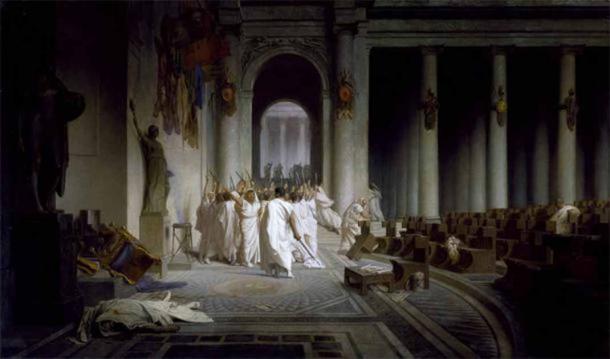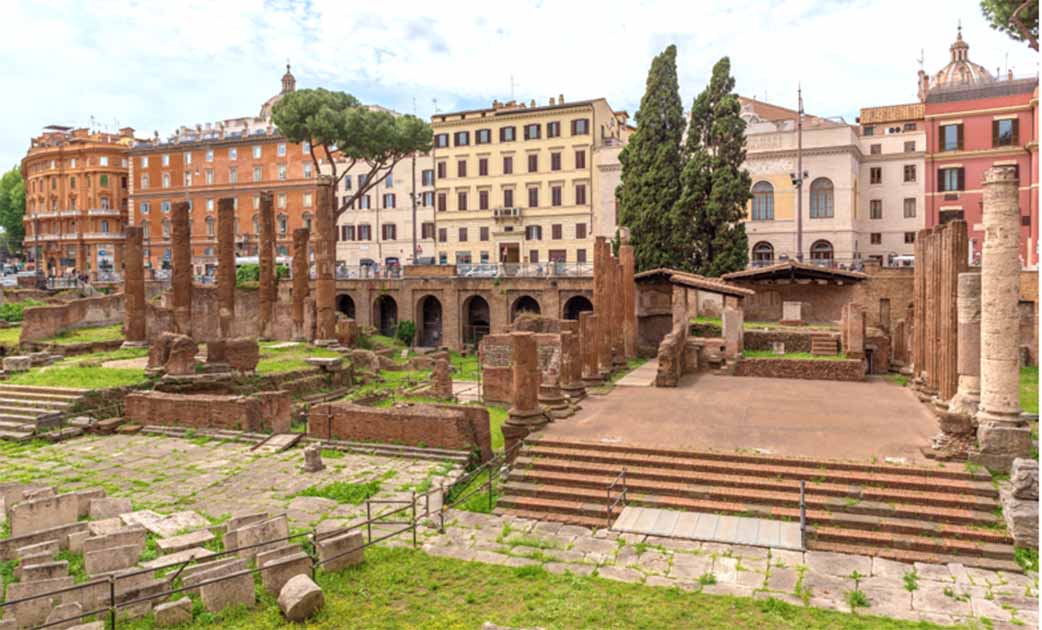“Et tu, Brute?” Rome to Reopen Square of Julius Caesar’s Assassination to Public
From this week, history enthusiasts, tourists, and other interested parties will be able to walk through the square where the famed Roman emperor, Julius Caesar, met his end through stabbing. Rome has planned to reopen a new walkaway on the ancient site lying in the capital’s central Largo Argentina square (named after the Latin name of Strasbourg, France and not the South American country), home to the remains of four temples.
Visiting the ‘Sacred Area’: Where Caesar was assassinated
The ruins of these temples are all below street level, and previously could only be viewed from behind barriers adjacent to a busy road junction.
Over centuries, the city had been built layer by layer, and the part where Caesar was stabbed kept getting submerged under the layers. Behind two of the temples lies a foundation and a wall that formed a part of the Pompey’s Curia, a large rectangular shaped hall that temporarily hosted the Senate, which ultimately served as the spot for the fatal stabbing.
“We know it with certainty because latrines were found on the sides” of Pompey's Curia, and ancient texts mentioned the latrines, said Claudio Parisi Presicce, an archaeologist and Rome's top official for cultural heritage, explaining why the conclusion about Pompey’s Curia had been made.
- Archaeologists uncover ancient Roman cult temple
- 150,000 fled for their lives, but were slaughtered by Julius Caesar army, bones reveal
In the late 1920s, as part of dictator Benito Mussolini's efforts to reshape the urban landscape, the temples emerged from the demolition of medieval-era buildings. Among them, there was a tower situated at the periphery of Largo Argentina that once adorned a medieval palace, reports The Associated Press.
Designated as A, B, C, and D, these temples were likely devoted to female deities. One of these temples, accessible via an impressive staircase and characterized by its circular shape, houses six remaining columns. It is widely believed to have been constructed as a tribute to Fortuna, the goddess associated with both chance and fertility.

The circular temple is attributed to Fortuna, due to a large statue of the goddess that was found there. (Alessio Damato/CC BY-SA 3.0)
Described as "one of the most well-preserved remnants of the Roman Republic," according to Parisi Presicce, the Mayor of Rome, Roberto Gualtieri, inaugurated the temples during a ceremonial ribbon-cutting event on Monday. Adjacent to the temples, a corridor showcases a black-and-white photograph capturing Mussolini himself cutting the ribbon back in 1929 when the excavated ruins were first presented to the public.
Next to to the temples, visitors can observe the travertine paving stones that Emperor Domitian laid down following a devastating fire in 80 AD, which ravaged a significant portion of Rome, including the Sacred Area.
Among the artifacts exhibited are remarkable findings from the excavation carried out in the previous century. Notably, there is a colossal stone head of one of the venerated deities from the temples, lacking a chin and lower lip. Additionally, a stone fragment depicting a winged angel of victory is also on display.
Over the years, a colony of cats thrived amidst the ruins, finding solace and comfort. Visitors and feline enthusiasts were allowed to feed and interact with them. During the recent ceremony, a black-and-white cat could be seen leisurely lounging on its back atop the remnants of a once-majestic column.
- The Mighty Wall of Hadrian, Emperor of Rome
- Rare Coin Celebrating Caesar’s Assassination Might Fetch £5 Million
Caesar’s Assassination: The Ides of March and the Dramatic Retelling by Shakespeare
His famed stabbing found a dramatic voice and retelling in Shakespeare’s play titled ‘Julius Caesar’, where Caesar is alleged to have remarked ‘Et tu Brute?’ (and you Brutus?) in reference to his confidante and brother-in-law Marcus Brutus, who played chief conspirator.
Ultimately, it was Brutus’ idea that to legitimize the removal of the cruel emperor, numbers were needed to highlight the tyranny and brutality of his rule, leading to almost 60 senators involved in the infamous stabbing. Caesar was stabbed on the 15th of March (the ‘Ides of March’) in 44 BC at a meeting of the Senate, the 74th day of the Roman calendar, considered widely as a turning point in Roman history.

The Death of Caesar by Jean-Léon Gérôme. (Public domain)
On the day of the assassination, Julius Caesar was scheduled to attend a meeting of the Senate at the Theatre of Pompey. Around 60 conspirators, led by Gaius Cassius Longinus and Marcus Junius Brutus, were involved in the plot to kill Caesar.
As Caesar entered the Senate chamber, the conspirators surrounded him, feigning petitions and requests for pardons. Suddenly, they drew concealed daggers and attacked Caesar simultaneously. According to historical accounts, Caesar initially defended himself, but when he saw that Brutus, whom he considered a friend, was also among the conspirators, he reportedly uttered the famous phrase "Et tu, Brute?"
The stabbing lasted for a few moments, and despite his efforts to resist, Caesar was overwhelmed by the multiple assailants. He suffered from approximately 23 stab wounds, though the exact number varies in different accounts. The attack proved fatal, and Caesar fell to the ground, succumbing to his injuries. The event also became a turning point in Shakespeare's play "Julius Caesar" and has since been depicted in various forms of literature, art, and media, symbolizing betrayal and political intrigue.
Top image: Largo di Torre Argentina square in Rome, Italy. Source: Pino Pacifico/Adobe Stock
By Sahir Pandey
References
D’Emilio, F. 2023. Ancient Roman temple complex, with ruins of building where Caesar was stabbed, opens to tourists. Available at: https://abcnews.go.com/International/wireStory/ancient-rome-temples-complex-ruins-building-caesar-stabbed-100204118.
Weir, K. 2023. Rome to open ancient square where Julius Caesar was killed. Available at: https://www.reuters.com/world/europe/rome-open-ancient-square-where-julius-caesar-was-killed-2023-06-19/.

















